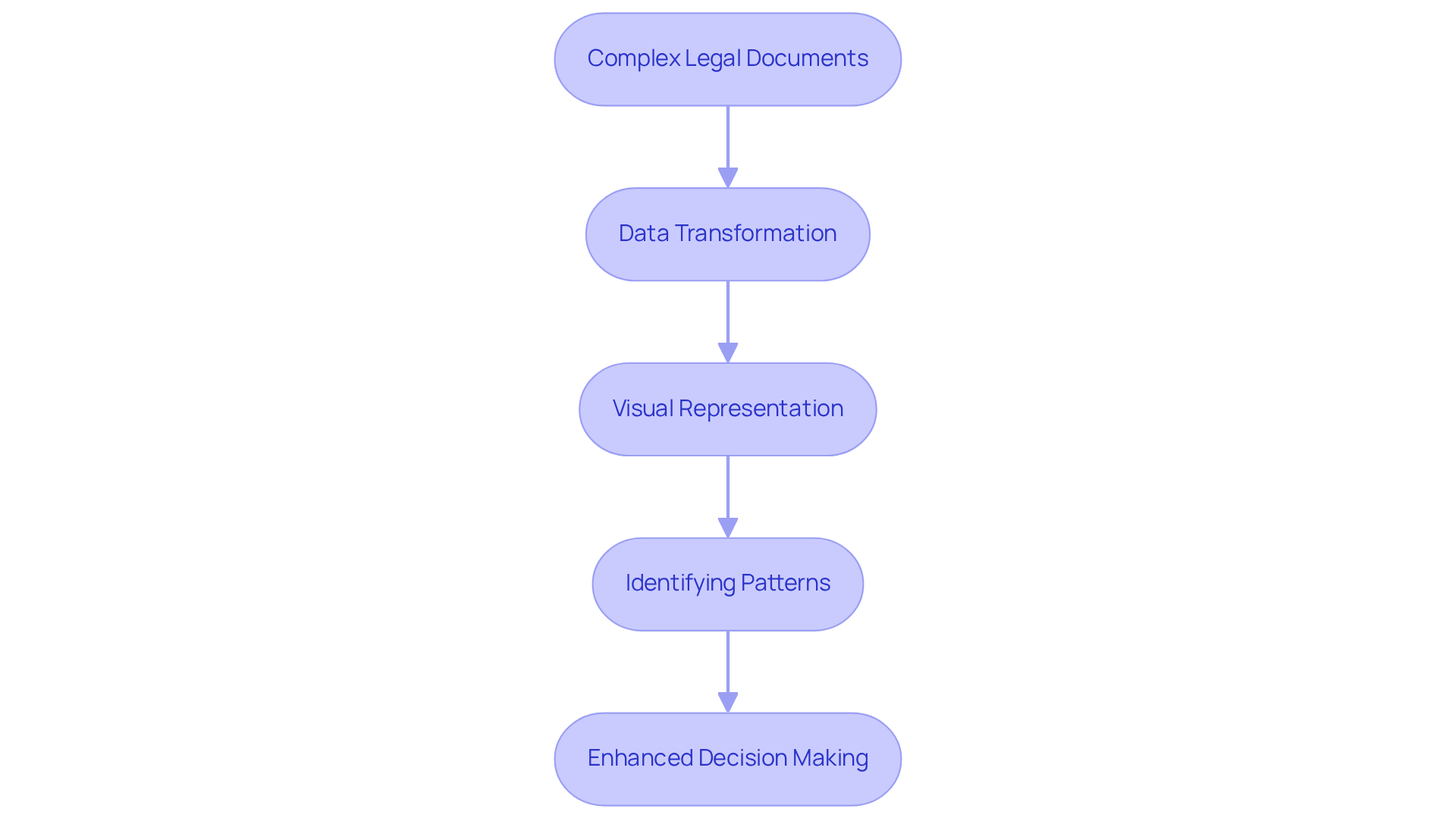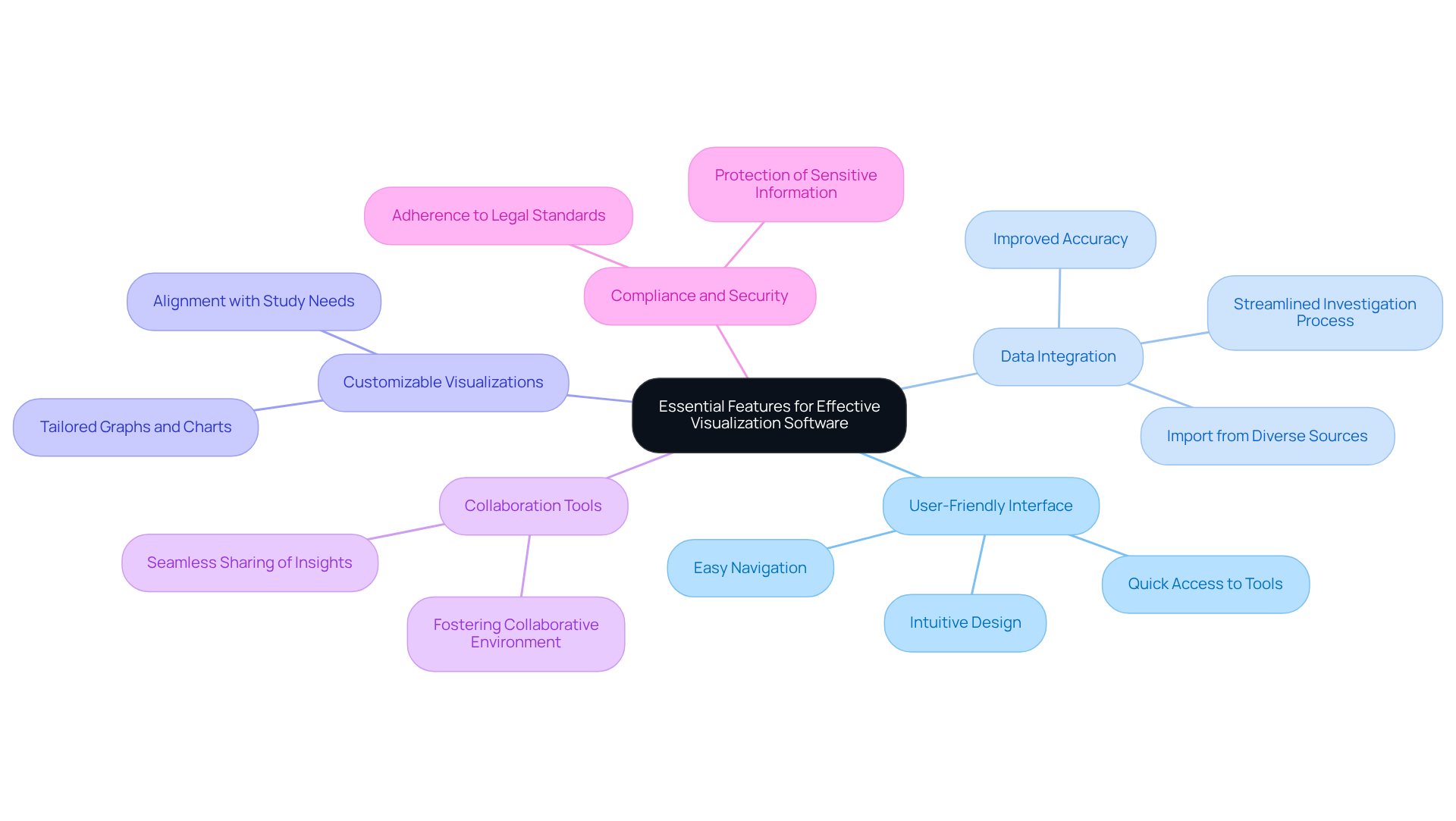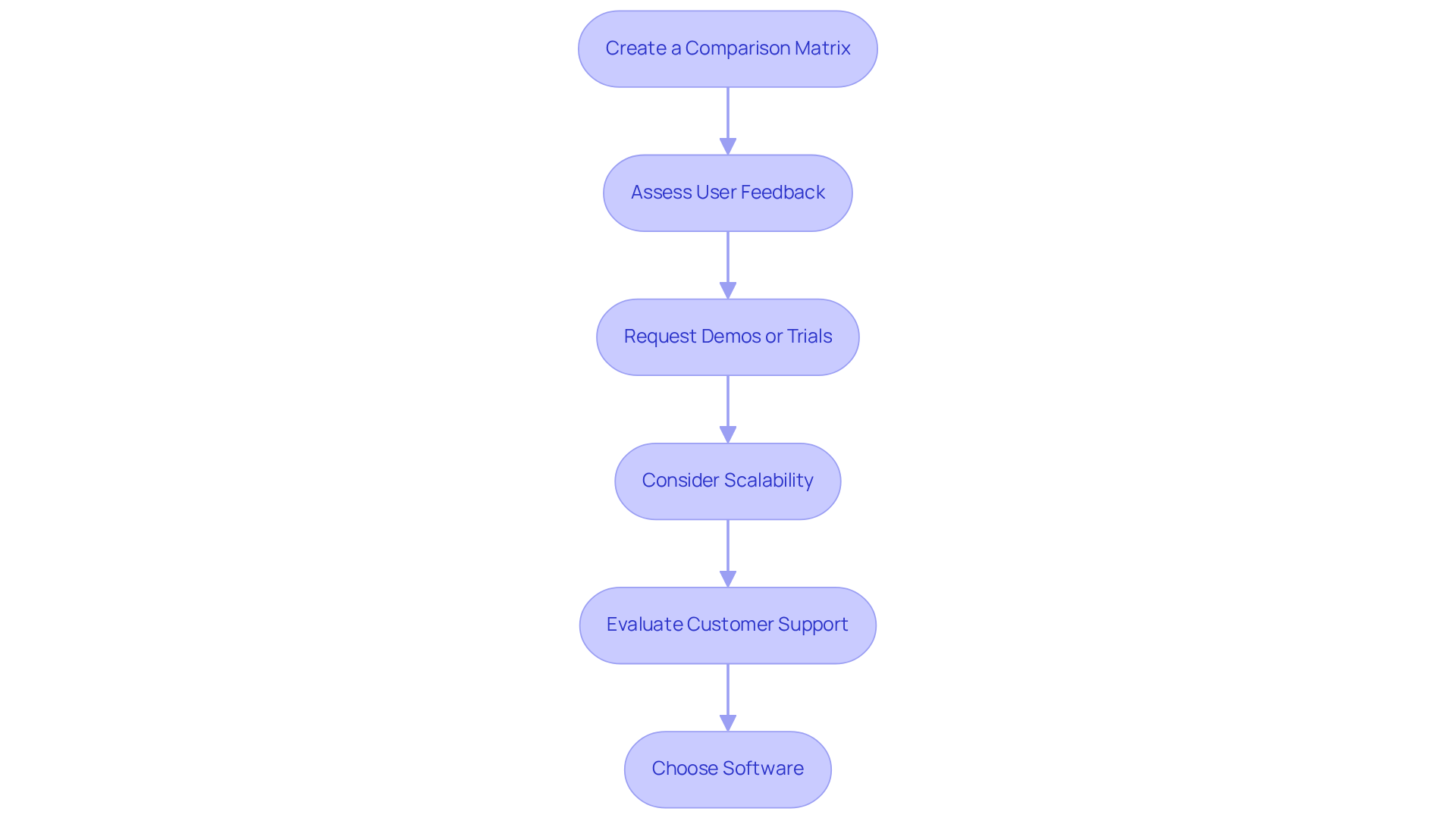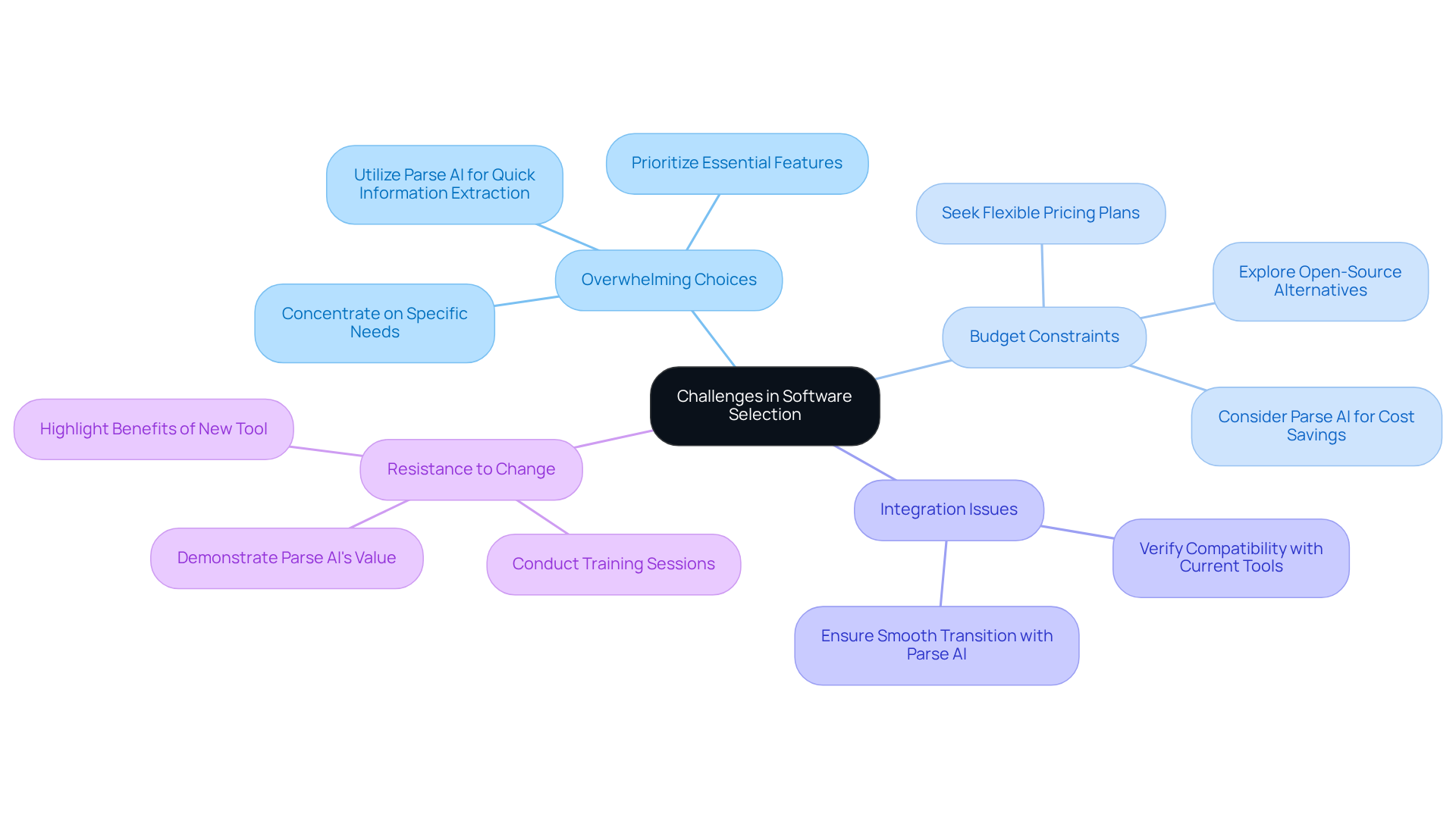Overview
The article underscores the critical importance of mastering property deed visualization software to enhance title research. This software transforms complex legal documents into easily interpretable visual formats, facilitating ownership analysis. Furthermore, the article discusses how visualization aids in identifying key information and spotting inconsistencies, ultimately leading to improved decision-making in property transactions. This capability is essential for navigating the complexities of title research, making it a valuable tool for professionals in the field.
Introduction
Property deed visualization software is transforming the landscape of title research, enabling professionals to navigate complex ownership documents with newfound clarity. By converting dense legal jargon into actionable insights, these innovative tools empower researchers to swiftly uncover critical information, including ownership histories and potential liens, with remarkable speed and accuracy.
However, given the multitude of options available, how can one ensure the selection of software that not only addresses current needs but also adapts to future challenges?
Understand the Importance of Property Deed Visualization in Title Research
Property deed visualization software plays a crucial role in ownership research by transforming complex legal documents into easily interpretable visual formats. This process enables property researchers to swiftly pinpoint such as ownership history, liens, and encumbrances.
Furthermore, by visualizing data, researchers can spot inconsistencies and patterns that may not be immediately apparent in text-heavy documents. For example, a timeline representation can demonstrate changes in ownership over time, assisting in clarifying any possible disputes or gaps in the ownership history.
Comprehending these visual signals is crucial for making knowledgeable choices in property dealings, ultimately resulting in more efficient and precise documentation outcomes.
Recent advancements in property deed visualization software, such as those developed by Parse AI, emphasize the importance of continuous improvement in this field. Consequently, integrating these innovations can greatly enhance the efficiency of naming investigation methods.

Identify Essential Features for Effective Visualization Software
When selecting property deed visualization software, it is essential to consider several key features that enhance usability and functionality. Look for software that offers:
- User-Friendly Interface: A clean, intuitive design that facilitates easy navigation and quick access to tools, crucial for maintaining productivity in title research.
- Data Integration: The ability to import information from diverse sources, including document titles, public records, and GIS data, which streamlines the investigation process and improves accuracy.
- Customizable Visualizations: Options to create tailored visual representations, such as graphs, charts, and maps, that align with specific study needs.
- Collaboration Tools: Features that enable team members to seamlessly share insights and findings, fostering a collaborative environment.
- Compliance and Security: Assurance that the application adheres to legal standards and protects sensitive information, thereby maintaining trust and integrity in title research.
Focusing on these essential features empowers title researchers to select property deed visualization software that not only meets their immediate needs but also enhances long-term efficiency and accuracy in their workflows. With the global projected to reach $13.46 billion by 2026, growing at a CAGR of 12.2% from 2021 to 2026, the demand for user-friendly and efficient representation tools is set to increase. Furthermore, according to Matterport, properties featuring 3D tours sell up to 31% faster and at higher prices, demonstrating the tangible benefits of investing in advanced imaging tools.

Evaluate and Compare Available Software Options
To effectively evaluate and compare available property deed visualization software, follow these steps:
- Create a Comparison Matrix: List potential application options along with their features, pricing, and user reviews. This will facilitate a side-by-side analysis, allowing you to identify which tools best meet your needs.
- Assess User Feedback: Look for testimonials and case studies from other title researchers to gauge the application's effectiveness in real-world scenarios. Notably, 37% of companies lack a clearly defined Customer Success strategy, underscoring the importance of understanding user experiences and outcomes.
- Request Demos or Trials: Take advantage of free trials or demonstrations to experience the application firsthand and assess its usability and functionality. Interacting with the application directly can offer insights that evaluations may not capture.
- Consider Scalability: Ensure that the application can grow with your needs, accommodating more complex projects or larger datasets as required. This flexibility is essential for lasting achievement in .
- Evaluate Customer Support: Research the level of customer support offered, including training resources, technical assistance, and community forums. A clearly defined Customer Success strategy can significantly enhance your overall experience, ensuring that you have the assistance needed to maximize the program's potential.
By systematically comparing program options and considering these factors, title researchers can confidently choose property deed visualization software that aligns with their operational needs and enhances their research capabilities. Incorporating insights from fellow researchers can further validate your choices, making the evaluation process more robust.

Troubleshoot Common Challenges in Software Selection
When selecting property deed visualization software, users often encounter several common challenges. Addressing these challenges effectively can streamline the decision-making process and enhance overall efficiency.
- Challenge: Overwhelming Choices: The abundance of software options can make it difficult to narrow down selections.
Solution: Concentrate on your specific needs and prioritize essential features to simplify your selection process. Furthermore, consider how Parse AI’s advanced technology can facilitate the quick extraction of crucial information, thereby easing your decision-making. - Challenge: Budget Constraints: High-quality applications frequently come with significant costs.
Solution: Seek applications that offer flexible pricing plans or explore open-source alternatives that deliver essential functionalities at a lower cost. For instance, Parse AI presents substantial cost savings compared to traditional title research methods, making it a prudent choice. - Challenge: Integration Issues: Certain applications may not integrate seamlessly with existing systems.
Solution: Before making a commitment, verify compatibility with your current tools and data sources. Parse AI is specifically designed to work harmoniously with existing workflows, ensuring a smooth transition. - Challenge: Resistance to Change: Team members may exhibit reluctance to adopt new tools.
Solution: Conduct training sessions and underscore the benefits of the new tool to foster acceptance among your team. Highlighting Parse AI’s dedication to and collaboration with land service professionals can effectively demonstrate its value and alleviate concerns.
By proactively addressing these challenges, title researchers can refine their software selection process for property deed visualization software and ensure the successful implementation of this tool, ultimately enhancing efficiency and accuracy in their workflows.

Conclusion
Mastering property deed visualization software is essential for enhancing the efficiency and accuracy of title research. By transforming complex legal documents into clear visual formats, this technology empowers researchers to swiftly identify key information, track ownership history, and uncover potential discrepancies. Furthermore, the integration of advanced visualization tools streamlines the research process and supports informed decision-making in property transactions.
This article highlights critical aspects of property deed visualization, including:
- The importance of user-friendly interfaces
- Data integration capabilities
- Customizable visualizations
It emphasizes the necessity for thorough evaluation when selecting software options, encouraging researchers to consider:
- User feedback
- Scalability
- Customer support
Additionally, addressing common challenges in the software selection process can significantly enhance the effectiveness of these tools.
Ultimately, embracing property deed visualization software represents a significant advancement for title researchers. As the real estate technology sector continues to evolve, investing in these advanced tools will not only improve research outcomes but also foster a more collaborative and informed environment. Researchers are encouraged to explore the latest software options available, ensuring they choose a solution that aligns with their specific needs and enhances their overall title research capabilities.
Frequently Asked Questions
What is the role of property deed visualization software in title research?
Property deed visualization software transforms complex legal documents into easily interpretable visual formats, enabling property researchers to quickly identify essential information such as ownership history, liens, and encumbrances.
How does visualizing data benefit property researchers?
Visualizing data allows researchers to spot inconsistencies and patterns that may not be obvious in text-heavy documents, helping them to clarify possible disputes or gaps in ownership history.
Why is it important to understand visual signals in property deed research?
Comprehending visual signals is crucial for making informed decisions in property dealings, leading to more efficient and accurate documentation outcomes.
What advancements have been made in property deed visualization software?
Recent advancements, such as those developed by Parse AI, highlight the importance of continuous improvement in property deed visualization, enhancing the efficiency of naming investigation methods.




